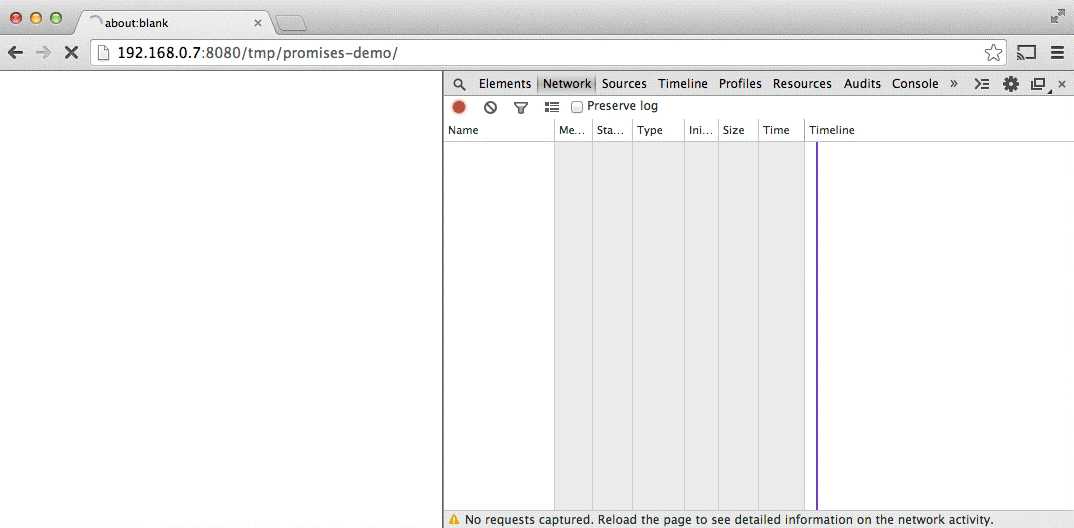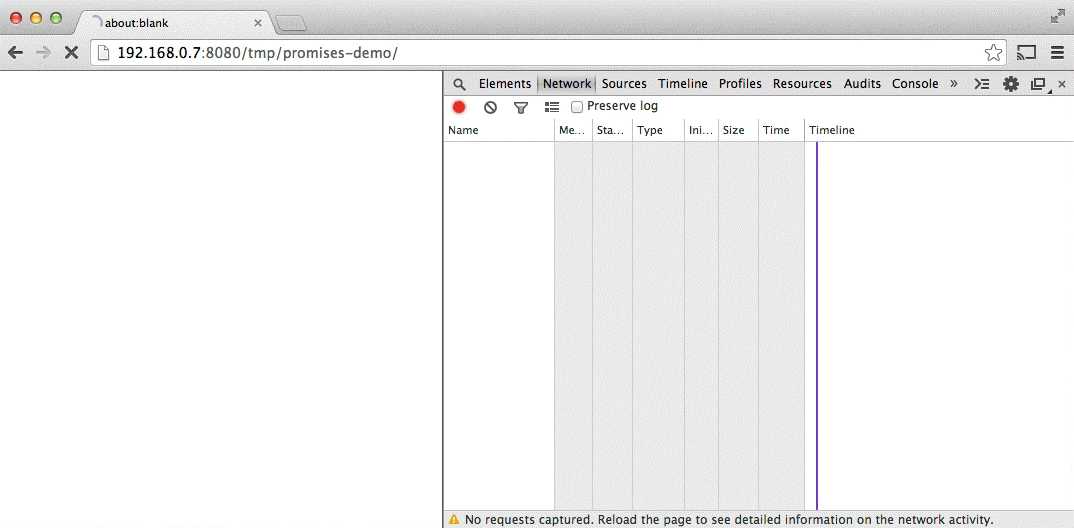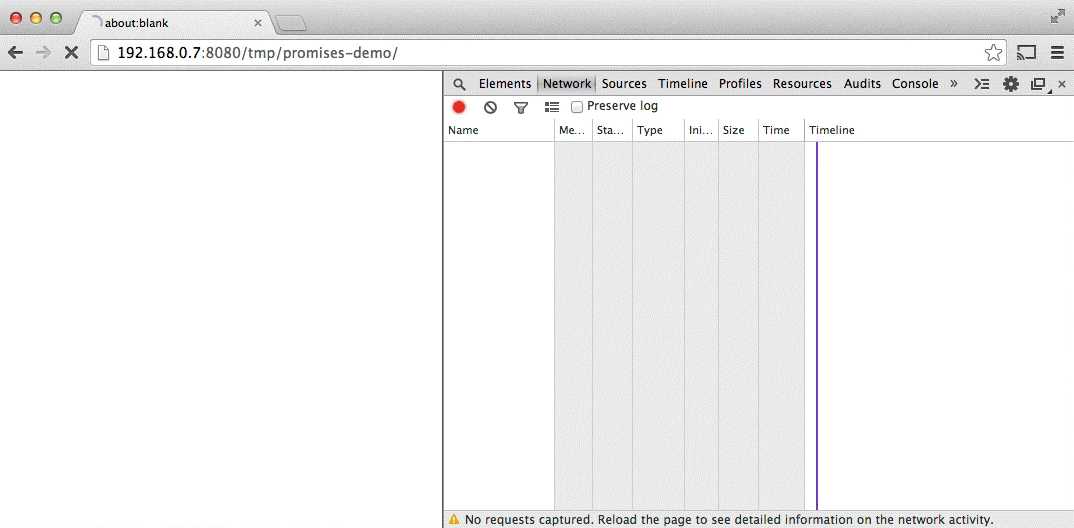标签:
Promise 代表着一个异步操作,这个异步操作现在尚未完成,但在将来某刻会被完成。
Promise 有三种状态
如果 Promise 操作 fulfilled 或者 rejected ,并且对应的处理函数被声明了,则该处理函数被调用。
事件监听器善于处理同一对象上重复发生的事情,例如按键、点击鼠标等。对于这些事件,你只关心添加回调函数之后的发生的事情。当处理结果导向的异步事件时,你的代码可能是
img1.callThisIfLoadedOrWhenLoaded(function() { // loaded }).orIfFailedCallThis(function() { // failed }); // and… whenAllTheseHaveLoaded([img1, img2]).callThis(function() { // all loaded }).orIfSomeFailedCallThis(function() { // one or more failed });
要实现同样的功能,Promise 的代码更加简洁,更加直观。
img1.ready().then(function() { // loaded }, function() { // failed }); // and… Promise.all([img1.ready(), img2.ready()]).then(function() { // all loaded }, function() { // one or more failed });
Promise 和 事件监听器很相似,除了以下几点
1. Promise 只经历一次执行,成功或者失败。Promise 不会被执行第二次,也不可以转变执行结果,即执行无法从成功变成失败,反之亦然。而事件监听器可以被反复执行。
2. 如果 Promise 已经执行完毕,成功或者失败,然后再给 Promise 添加对应的回调函数,那么这个对应的回调函数仍然会被执行。也就是说,Promise 添加回调函数后,回调函数先检查在自己被添加之前事件是否已发生,如果发生则执行,如果没有发生就继续等待。而事件监听器只对自己被添加后的事件负责,忽略在自己被添加前的事件。
上面两点非常有利于处理结果导向的异步事件。因为你只需要关系事件发生的结果,成功或者失败,而不需了解事件发生的准确时间。
Promise 早已存在一些库里面,例如
类库中的 Promise 实现大多都遵循标准行为,Promises/A+。 但是 API 会有些不一样。 Javascript 自带的 Promise 采用类似 RSVP.js 的 API 。
var promise = new Promise(function(resolve, reject) { // do a thing, possibly async, then… if (/* everything turned out fine */) { resolve("Stuff worked!"); } else { reject(Error("It broke")); } });
Promise 构造函数接受一个回调函数作为参数。在创建 Promise 对象时候,执行该回调函数。根据回调函数的结果,成功或者失败,把执行控制器交给 reolve() 或者 reject() 函数。不过 reolve() 或 reject() 正在被执行的时间是在他们通过 Promise.then() 添加之后。
promise.then(function(result) { console.log(result); // "Stuff worked!" }, function(err) { console.log(err); // Error: "It broke" });
Promise.then() 接受两个参数,一个用于处理 Promise 执行成功的情况,另一个用于处理 Promise 失败的情况。两个参数都是可选的,所以可以只传函数给第一个参数,用于处理 Promise 成功的情况,也可以只传函数给第二个参数,用于处理 Promise 失败的情况。
Promise.prototype.then() 和 Promise.prototype.catch() 返回的是一个 Promise ,所以可以形成链式调用。链式调用可用用于值传递,或者依次地进行后续的异步操作。
var promise = new Promise(function(resolve, reject) { resolve(1); }); promise.then(function(val) { console.log(val); // 1 return val + 2; }).then(function(val) { console.log(val); // 3 });
当 then() 只是简单地调用另一个函数时,可以只传另一个函数的函数名。例如
get(‘story.json‘).then(function(response) { return JSON.parse(response); }).then(function(response) { console.log("Yey JSON!", response); });
可以简化为
get(‘story.json‘).then(JSON.parse).then(function(response) { console.log("Yey JSON!", response); });
实战代码如下
function getJSON(url) { return get(url).then(JSON.parse); }
如果 then 返回一个值,下一个 then 就会接受这个值继续执行。如果 then 返回另一个 Promise 的对象,那么下一个 then 就等待,直到返回的 Promise 执行完(成功或者失败)。
getJSON(‘story.json‘).then(function(story) { return getJSON(story.chapterUrls[0]); }).then(function(chapter1) { console.log("Got chapter 1!", chapter1); });
发送一个 story.json 的请求,获得的结果是一个 story 对象,包含着多个 chapter 的 URL。根据第一个 chapter URL ,再次请求 JSON 数据。执行成功后,最后运行 console.log 。
已知一个目标资源 story.json,需要实现下面几步
1. 向 story.json 发送请求,获得各个章节的 URL,
2. 向各个章节的 URL 发送请求,分别获得各章节内容
3. 将章节内容添加到 HTML 页面中
由于是同步请求,所有请求都依次阻塞进行。在请求过程中页面也会被阻塞,无进行其他操作。这种方式可以实现数据加载,但是用户体验差。
try { var story = getJSONSync(‘story.json‘); addHtmlToPage(story.heading); story.chapterUrls.forEach(function(chapterUrl) { var chapter = getJSONSync(chapterUrl); addHtmlToPage(chapter.html); }); addTextToPage("All done"); } catch (err) { addTextToPage("Argh, broken: " + err.message); } document.querySelector(‘.spinner‘).style.display = ‘none‘;
getJSON(‘story.json‘).then(function(story) { addHtmlToPage(story.heading); // TODO: for each url in story.chapterUrls, fetch & display }).then(function() { // And we‘re all done! addTextToPage("All done"); }).catch(function(err) { // Catch any error that happened along the way addTextToPage("Argh, broken: " + err.message); }).then(function() { // Always hide the spinner document.querySelector(‘.spinner‘).style.display = ‘none‘; });
上面是一个框架代码,加载每一章节的功能每一实现。由于数组的 forEach 函数不是异步操作,所以无法简单地使用 forEach 对每一章节进行异步请求。可以将数组转换为 Promise 队列来实现遍历效果。
// Start off with a promise that always resolves var sequence = Promise.resolve(); // Loop through our chapter urls story.chapterUrls.forEach(function(chapterUrl) { // Add these actions to the end of the sequence sequence = sequence.then(function() { return getJSON(chapterUrl); }).then(function(chapter) { addHtmlToPage(chapter.html); }); });
或者用 array.reduce 来实现
// Loop through our chapter urls story.chapterUrls.reduce(function(sequence, chapterUrl) { // Add these actions to the end of the sequence return sequence.then(function() { return getJSON(chapterUrl); }).then(function(chapter) { addHtmlToPage(chapter.html); }); }, Promise.resolve());
将框架代码和加载章节的代码组合起来
getJSON(‘story.json‘).then(function(story) { addHtmlToPage(story.heading); return story.chapterUrls.reduce(function(sequence, chapterUrl) { // Once the last chapter‘s promise is done… return sequence.then(function() { // …fetch the next chapter return getJSON(chapterUrl); }).then(function(chapter) { // and add it to the page addHtmlToPage(chapter.html); }); }, Promise.resolve()); }).then(function() { // And we‘re all done! addTextToPage("All done"); }).catch(function(err) { // Catch any error that happened along the way addTextToPage("Argh, broken: " + err.message); }).then(function() { // Always hide the spinner document.querySelector(‘.spinner‘).style.display = ‘none‘; });
实现的效果如下:

现在,能执行异步无阻塞地依次加载数据,并且先加载先显示。不过,这种加载方式还有优化空间。
并行加载数据,全部加载后同时显示。效果如下

并行加载数据,根据章节顺序,依次显示各个加载完成的章节。这种加载方式的效果最后。使用 Chrome 浏览器时候,感觉数据加载很快,猜想就是用这种方式进行数据加载的。
效果如下

最后两个优化版的思路和代码参考 JavaScript Promise, Jake Archibald
参考资料
JavaScript Promise, Jake Archibald
标签:
原文地址:http://www.cnblogs.com/TonyYPZhang/p/5813011.html